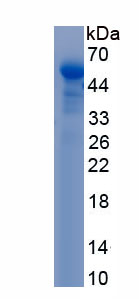Active Apolipoprotein A4 (APOA4)
ApoA-IV; ApoAIV; Apo-A4
- Product No.APB967Hu02
- Organism SpeciesHomo sapiens (Human) Same name, Different species.
- Buffer FormulationPBS, pH7.4, containing 0.01% SKL, 5% Trehalose.
- Traits Freeze-dried powder
- Purity> 80%
- Isoelectric Point5.2
- ApplicationsCell culture; Activity Assays.
- DownloadInstruction Manual
- UOM 10µg50µg 200µg 1mg 5mg
- FOB
US$ 260
US$ 650
US$ 1300
US$ 3900
US$ 9750
For more details, please contact local distributors!
ACTIVITY TEST

Apolipoprotein A4 (APOA4) is a lipid-binding protein, which is primarily synthesized in the small intestine, packaged into chylomicrons, and secreted into intestinal lymph during fat absorption. In the circulation, apoA-IV is present on chylomicron remnants, high-density lipoproteins, and also in lipid-free form. ApoA-IV is involved in a myriad of physiological processes such as lipid absorption and metabolism, anti-atherosclerosis, platelet aggregation and thrombosis, glucose homeostasis and food intake. Besides, Apolipoprotein H (APOH) has been identified as an interactor of APOA4, thus a functional binding ELISA assay was conducted to detect the interaction of recombinant human APOA4 and recombinant bovine APOH. Briefly, APOA4 was diluted serially in PBS with 0.01% BSA (pH 7.4). Duplicate samples of 100 μl were then transferred to APOH-coated microtiter wells and incubated for 1h at 37℃. Wells were washed with PBST and incubated for 1h with anti-APOA4 pAb, then aspirated and washed 3 times. After incubation with HRP labelled secondary antibody for 1h at 37℃, wells were aspirated and washed 5 times. With the addition of substrate solution, wells were incubated 15-25 minutes at 37℃. Finally, add 50 µL stop solution to the wells and read at 450/630 nm immediately. The binding activity of recombinant human APOA4 and recombinant bovine APOH was shown in Figure 1, the EC50 for this effect is 0.16 ug/mL.
USAGE
Reconstitute in 10mM PBS (pH7.4) to a concentration of 0.1-1.0 mg/mL. Do not vortex.
STORAGE
Avoid repeated freeze/thaw cycles. Store at 2-8°C for one month. Aliquot and store at -80°C for 12 months.
STABILITY
The thermal stability is described by the loss rate. The loss rate was determined by accelerated thermal degradation test, that is, incubate the protein at 37°C for 48h, and no obvious degradation and precipitation were observed. The loss rate is less than 5% within the expiration date under appropriate storage condition.
GIVEAWAYS
INCREMENT SERVICES
-
 BCA Protein Quantification Kit
BCA Protein Quantification Kit
-
 Molecular Mass Marker for Protein
Molecular Mass Marker for Protein
-
 Monoclonal Antibody Customized Service
Monoclonal Antibody Customized Service
-
 Polyclonal Antibody Customized Service
Polyclonal Antibody Customized Service
-
 Protein Activity Test Experiment Service
Protein Activity Test Experiment Service
-
 Electrophoretic Mobility Shift Assay (EMSA) Experiment Service
Electrophoretic Mobility Shift Assay (EMSA) Experiment Service
-
 Buffer
Buffer
-
 Lentivirus Packaging Experiment Service
Lentivirus Packaging Experiment Service
-
 Adenovirus Packaging Experiment Service
Adenovirus Packaging Experiment Service
-
 Real Time PCR Experimental Service
Real Time PCR Experimental Service
-
 Spike RBD Protein (S-RBD)
Spike RBD Protein (S-RBD)
-
 Protein G
Protein G
-
 Protein A
Protein A
| Magazine | Citations |
| Biochimica et Biophysica Acta | Hepatic lipase- and endothelial lipase-deficiency in mice promotes macrophage-to-feces RCT and HDL antioxidant properties PubMed: 23328279 |
| Exp Ther Med. | Differential plasma proteome analysis in patients with high?altitude pulmonary edema at the acute and recovery phases Pubmed:24940404 |
| EuPA Open Proteomics | Human maternal plasma proteomic changes with parturition Sciencedirect:S2212968514000506 |
| BJOG | Development of concise audit standards for unplanned return to theate following gynaecological surgery at Gloucestershire Royal Hospital Doi: 10.1111 |
| Diagnostics | Systemic Alterations of Immune Response-Related Proteins during Glaucoma Development in the Murine Model DBA/2J Pubmed: 32585848 |
| VETERINARY PATHOLOGY | Pathology and Proteomics-Based Diagnosis of Localized Light-Chain Amyloidosis in Dogs and Cats Pubmed: 32880234 |
| Cancer Cell Int | Discovery and validation of FBLN1 and ANT3 as potential biomarkers for early detection of cervical cancer 33602229 |
| Catalog No. | Related products for research use of Homo sapiens (Human) Organism species | Applications (RESEARCH USE ONLY!) |
| APB967Hu02 | Active Apolipoprotein A4 (APOA4) | Cell culture; Activity Assays. |
| RPB967Hu02 | Recombinant Apolipoprotein A4 (APOA4) | Positive Control; Immunogen; SDS-PAGE; WB. |
| RPB967Hu01 | Recombinant Apolipoprotein A4 (APOA4) | Positive Control; Immunogen; SDS-PAGE; WB. |
| PAB967Hu01 | Polyclonal Antibody to Apolipoprotein A4 (APOA4) | WB; IHC |
| PAB967Hu02 | Polyclonal Antibody to Apolipoprotein A4 (APOA4) | WB; IHC |
| MAB967Hu21 | Monoclonal Antibody to Apolipoprotein A4 (APOA4) | WB |
| MAB967Hu22 | Monoclonal Antibody to Apolipoprotein A4 (APOA4) | WB |
| MAB967Hu23 | Monoclonal Antibody to Apolipoprotein A4 (APOA4) | WB |
| SEB967Hu | ELISA Kit for Apolipoprotein A4 (APOA4) | Enzyme-linked immunosorbent assay for Antigen Detection. |
| SCB967Hu | CLIA Kit for Apolipoprotein A4 (APOA4) | Chemiluminescent immunoassay for Antigen Detection. |
| LMB967Hu | Multiplex Assay Kit for Apolipoprotein A4 (APOA4) ,etc. by FLIA (Flow Luminescence Immunoassay) | FLIA Kit for Antigen Detection. |
| KSB967Hu01 | ELISA Kit DIY Materials for Apolipoprotein A4 (APOA4) | Main materials for "Do It (ELISA Kit) Yourself". |







